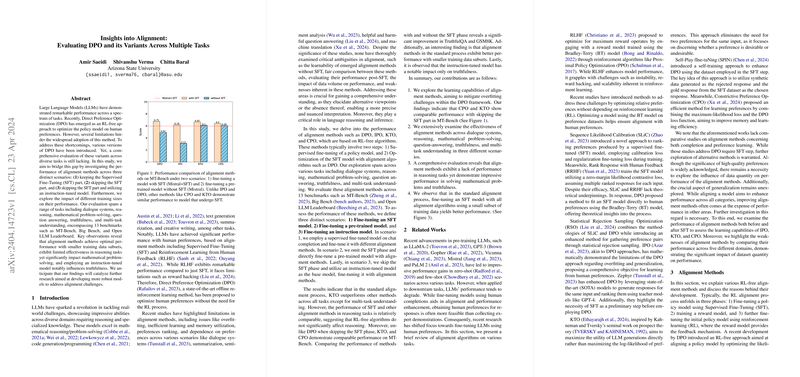Exploration of Direct Preference Optimization and Its Variants in Optimizing Human Preferences in LLMs
Introduction
Inevaluating the effectiveness of various alignment methods on LLMs, this paper scrutinizes Direct Preference Optimization (DPO) alongside related iterations like IPO, KTO, and CPO. This comparison spans several tasks, testing the utility of different alignment strategies beyond standard Supervised Fine-Tuning (SFT) in contexts such as dialogue systems, reasoning capabilities, mathematical problem-solving, truthfulness, and multi-task performance.
Analysis of Alignment Methods
Different RL-free alignment methods, including DPO, IPO, KTO, and CPO, are evaluated for their capacity to optimize models without the complexity of reinforcement learning algorithms. Each method adjusts the policy model's preferences based on varying strategies:
- DPO: Focuses on the preference likelihood between chosen and unchosen responses by optimizing a distinct loss function that involves the sigmoid function and log odds of policy model probabilities.
- IPO: Provides a more comprehensive objective that aims to rectify issues like overfitting in DPO by enforcing a squared error minimization on the utility differences.
- KTO: Inspired by prospect theory, which does not necessitate dual preferences and uses utility outcomes directly to align the model.
- CPO: Streamlines the DPO process by excluding the reference model from training, alleviating memory overheads and enhancing computational efficiency.
Experiments and Outcomes
The experimentation phase examines three scenarios:
- Fine-tuning SFT models: Here, the paper found that KTO generally excels against other methods, particularly in mathematical tasks.
- Direct tuning of pre-trained models: Contrary to what might be expected, KTO and CPO demonstrate capable performance even without the SFT pre-phase, matching what is observable with SFT models in dialogue systems, as measured by MT-Bench.
- Using instruction-tuned models: Perhaps the most striking assertion of this research is noticeable here, where alignment methods significantly affect truthfulness metrics.
Key experimental metrics derived from multiple respected benchmarks (such as MT-Bench, GSM8K, and TruthfulQA) illustrate a profound influence by alignment methods, albeit with variable dependency on factors like task type and training data size. Across varying evaluations, the performance susceptibility to data volume is clear, with smaller subsets favoring better outcomes.
Discussion on Practical and Theoretical Implications
This systematic investigation into alignment methods sheds light on their scalability, efficiency, and effectiveness, fostering a deeper understanding of their operability and limitations in real-world applications. The observation that instructional tuning notably enhances truthfulness presents a valuable pathway for further explorations into making LLMs more honest and reliable interlocutors. Additionally, the findings contribute to ongoing discussions about the necessity and efficiency of SFT phases in the alignment process, offering tangible alternatives for refinement through models like KTO and IPO.
Future Directions
The outcomes underscore a necessity for continued research in alignment mechanisms, especially across broader and more complex datasets and tasks. Future work could extend these initial findings into domains critically needing robust alignment, such as automated content generation and interactive systems requiring nuanced human-like understanding. The dialogue opened by these comparisons between SFT-based and direct-tuned models also prompts a richer analysis of training methodologies and their impact on the generalizability and adaptability of LLMs across varied applications.
In sum, this paper not only clarifies the operational terrain of newer RL-free alignment methods but also points toward their nuanced applicabilities and limitations, crafting a roadmap for future research aimed at optimizing LLM alignments with human preferences.
